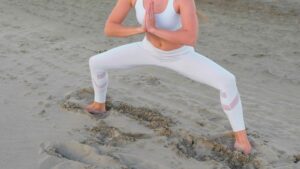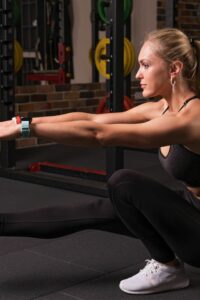The Role of Squats in Dance Performance Enhancement
Dance demands strength, flexibility, and control, making squats an ideal exercise. They build lower body strength, aid balance, and improve stability crucial for various dance styles.
1. Plie Squats
Plie squats are quintessential for dancers, especially in ballet or contemporary styles. This deep squat targets the inner thighs, quads, and glutes, mimicking movements often found in dance routines.

2. Sumo Squats
This variation involves a wider stance, activating different muscle groups such as the inner thighs and glutes. Sumo squats aid in building strength and stability in wider dance positions.
3. Jump Squats
Dynamic and explosive, jump squats enhance power and agility qualities crucial for jumps, leaps, and quick movements in dance routines.
4. Single-Leg Squats
Targeting each leg independently, these squats improve balance and strength, aiding in executing complex movements gracefully.

5. Back Squats
Utilizing added weights, back squats build overall leg strength, supporting various dance styles that require endurance and power.
How Squats Impact Dance Performance
Strength Building: Squats strengthen the lower body, crucial for executing movements with control and precision.
Improved Flexibility: Regular squatting can enhance hip flexibility, allowing dancers to achieve wider ranges of motion.
Enhanced Stability: Stronger leg muscles contribute to better balance and stability, reducing the risk of injury during challenging dance moves.
Power Generation: Squats help in generating power for explosive dance movements like jumps and lifts.
So.
Squats, when incorporated into a dancer’s training regimen, can significantly improve performance by enhancing strength, flexibility, and stability. They cater to various aspects crucial for mastering intricate dance moves across different styles.
Improving your dance performance involves a holistic approach, and integrating these targeted squats into your routine can certainly contribute to mastering the artistry of dance.
Integrating Squats into Dance Training
To optimize the benefits of squats for dance performance, it’s essential to incorporate them strategically into your training routine.
Frequency and Consistency
Regular Practice: Aim for at least 2-3 sessions per week dedicated to squat variations.
Progressive Overload: Gradually increase repetitions, sets, or resistance to continually challenge your muscles.
Proper Technique
Alignment: Maintain proper form to prevent injury. Keep knees aligned with toes, chest lifted, and core engaged.
Depth: Focus on quality over quantity. Full range of motion is crucial for maximum muscle engagement.
Breathing: Inhale while descending and exhale while rising to maintain stability and rhythm.
Supplementary Exercises
Core Strengthening: Include planks, Russian twists, or bicycle crunches to support stability during complex dance moves.
Flexibility Training: Combine squats with stretching exercises to enhance flexibility, aiding in achieving graceful movements.
Balanced Training Approach
Cross-Training: Incorporate other forms of exercise like yoga or Pilates to complement squat exercises and prevent muscle imbalances.
Rest and Recovery: Allow sufficient rest between sessions to prevent overexertion and promote muscle repair.
Consultation and Progress Tracking
Professional Guidance: Consider consulting a fitness trainer or dance instructor to tailor squats to your specific dance style and individual needs.
Tracking Progress: Monitor improvements in strength, flexibility, and stability to gauge the effectiveness of your training routine.
Conclusion
Squats serve as a cornerstone in enhancing dance performance, offering an array of benefits that cater to the physical demands of various dance styles. When integrated strategically and consistently, these exercises contribute significantly to a dancer’s strength, stability, and flexibility.
By incorporating targeted squats, maintaining proper technique, and adopting a well-rounded training approach, dancers can elevate their performance levels and excel in their artistry on stage.
Remember, the key lies in dedication, consistency, and a holistic approach to training, ensuring a harmonious blend of strength, agility, and grace in your dance routines.
External Resources:
American Council on Exercise – Benefits of Squats
Dance Spirit – How Strength Training Can Improve Your Dancing
Healthline – The Benefits of Squats for Strength, Flexibility, and Health
Integrate these squat variations into your routine, maintain consistency, and witness the transformative impact they can have on your dance performance!
Comparison tabular
| Squat Variation | Key Focus | Benefits for Dance | Level | Additional Tips |
|---|---|---|---|---|
| Plie Squats | Inner thighs, quads, glutes | Mimics dance movements, strengthens lower body | Beginner | Keep heels down, maintain turnout |
| Sumo Squats | Inner thighs, glutes | Strengthens wider stances, enhances stability | Intermediate | Widen stance gradually, engage core |
| Pistol Squats | Unilateral strength, balance | Builds control, aids balance and stability | Advanced | Start with assisted versions, focus on form and balance |
| Jump Squats | Power, agility | Improves explosive movements, enhances agility | Intermediate | Land softly, engage core and glutes |
| Single-Leg Squats | Balance, strength | Enhances unilateral stability, improves balance | Intermediate | Use support initially, focus on control and depth |
| Back Squats | Overall leg strength | Builds leg power and endurance for sustained dance movements | Intermediate | Maintain proper back alignment, start with lighter weights |
Key Insights:
Level: Each squat variation corresponds to different levels of difficulty, catering to beginners, intermediate, and advanced practitioners.
Focus: Highlights the primary muscle groups targeted by each squat variation, crucial for dancers’ needs.
Benefits: Summarizes how each squat variation contributes to enhancing dance performance through strength, balance, and agility.
Additional Tips: Offers guidance or recommendations to execute each squat variation effectively.
This table provides a snapshot of various squat types, their focus, benefits for dance, recommended levels, and additional tips for optimal execution. Incorporating a mix of these squats into a dancer’s routine can yield comprehensive improvements in performance.
Wrapping up
Improving dance performance is a journey that involves dedication, practice, and a tailored training regimen. Squats play a pivotal role in enhancing strength, stability, and flexibility, offering dancers a robust foundation to excel in their artistry.
By integrating a variety of squat variations, maintaining proper technique, and adopting a holistic approach to training, dancers can unlock their potential and elevate their performances on stage. Remember, consistency and dedication are key. Embrace the challenge, enjoy the progress, and watch how these targeted exercises transform your dance abilities.
So, step into your routine, plié, jump, and squat your way to becoming a stronger, more agile, and graceful dancer. Your commitment to mastering these exercises will undoubtedly reflect in your captivating performances. Keep dancing and keep pushing the boundaries of your artistry!

Hey there, it’s Mike Rrsq, the Editor-in-Chief over at Jsquat.com, and I’m absolutely obsessed with all things squat fitness! I’ve been lucky enough to get some serious recognition for my work in this field. With a solid background in the fitness and wellness industry, I’ve been there right from the get-go, helping shape this website into what it is today.
You see, I’m not just the boss around here; I’m also a passionate contributor. I love sharing my insights through my articles, and trust me, they’re not your run-of-the-mill stuff. Each piece I write is a labor of love, filled with my expertise and real-world experience in the fitness universe. So, if you’re into fitness and looking for some inspiration, you’re in the right place!
Related Posts
- The Top 3 Effective Squat Variations for Improved Weightlifting Performance in 28-year-old male
Weightlifting demands a robust foundation, and the right squat variation can be a game-changer for…
- The best 5 most effective squat variations you need for better basketball performance
Basketball demands a unique blend of strength, agility, and explosive power. Choosing the right squat…
- The Top 3 Effective Squat Variations you need for better swimming performance.
Swimming is an intricate sport that demands a blend of strength, endurance, and technique. While…
- The best 3 most effective squat variations you need for better soccer performance.
Squats are a foundational exercise for athletes across various sports, and for soccer players, they…
- The Top 3 Effective Squat Variations you need for better volleyball performance
Volleyball demands agility, power, and endurance. As an athlete, fine-tuning your performance can be the…
- The top 4 effective squat Variations 20-year-old females need for better Olympic lifting performance
For a 20-year-old female aiming to enhance Olympic lifting performance, incorporating specific squat variations can…
- The top 3 effective squat Variations 23-year-old males need for better powerlifting performance
Powerlifting is a thrilling sport that demands strength, technique, and dedication. Among the foundational exercises,…
- The Top 3 Effective Squat Variations that you need for better cycling performance.
Cycling demands more than just strong legs it requires a robust core, stability, and endurance…
